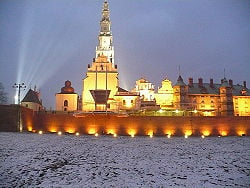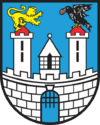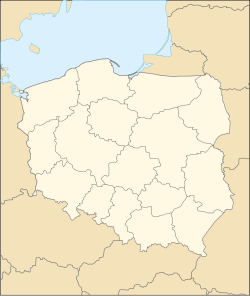Częstochowa
| Częstochowa | |||
| Jasna Góra Monastery | |||
|
|||
| Motto: Częstochowa to dobre miasto (Częstochowa is a good city) |
|||
| Coordinates: 50°48′N 19°7′E | |||
|---|---|---|---|
| Country | |||
| Voivodeship | Silesian | ||
| County | city county | ||
| Established | 11th century | ||
| Town rights | 1356 | ||
| Government | |||
| - Mayor | Tadeusz Wrona | ||
| Area | |||
| - City | 160 km² (61.8 sq mi) | ||
| Population (2006) | |||
| - City | 246,129 | ||
| - Density | 1,538.3/km² (3,984.2/sq mi) | ||
| - Metro | 400,000 | ||
| Time zone | CET (UTC+1) | ||
| - Summer (DST) | CEST (UTC+2) | ||
| Postal code | 42-200 to 42-229, 42-263, 42-271, 42-280, 42-294 | ||
| Area code(s) | +48 34 | ||
| Car plates | SC | ||
| Website: http://www.czestochowa.pl/ | |||
Częstochowa (German: Tschenstochau, Yiddish: טשענסטעכאוו-Chenstekhov) is a city in south-central Poland on the Warta River. It was formed from two settlements: Old Częstochowa, founded in the 13th century; and Jasna Góra, founded in the 14th; the two were merged in 1826.
The town is known for the famous Paulist monastery of Jasna Góra that is the home of the Black Madonna painting, a shrine of the Virgin Mary, as well as valuable frescoes. The fortified monastery was a stronghold for Polish forces during the Swedish invasions of 1655 and 1705. There is also a Lusatian culture excavation site and museum in the city and ruins of a medieval castle in Olsztyn, approximately 15 kilometers (ca. 10 mi) from the city center. These sites attract thousands of pilgrims a year to the city.
The city of approximately 250,000 inhabitants is an important industrial city with glass and paper manufacturing, textile mills, chemical and food processing centers, as well as an iron and steel plant. From 1975 - 1998 it served as the capital of Częstochowa Voivodeship.
Name
The name Częstochowa means "Częstoch's place" and comes from the personal name Częstoch, mentioned in the mediaeval documents also as Częstobor and Częstomir. The original name was mentioned (spelled as Czanstochowa) in 1220, (or spelled as Częstochow) in 1382 and 1558.
The village of Częstochówka was a separate municipality mentioned in the 14th century as the Old Częstochowa (Antiquo Czanstochowa, 1382) and Częstochówka in 1470-1480.
The city was also known in German as Tschenstochau and in Russian as Ченстохов (Chenstokhov).
History
1200s-1500s
The village of Częstochowa was founded in 11th century. It is first mentioned as a village in historical documents from 1220. In 1382 the Paulist monastery of Jasna Góra was founded by Władysław Opolczyk (Ladislav of Opole) - the Polish Piast prince of Upper Silesia. Two years later the monastery received its famous Black Madonna icon of the Virgin Mary and in subsequent years became a center of pilgrimage, contributing to the growth of the adjacent town. Before 1377 Częstochowa received a town charter, which was later changed to the Magdeburg Law in 1502.
1600s-1700s
In the 17th century the local monastery was converted into a fortress, which was one of the pockets of Polish resistance against the Swedish armies during The Deluge in 1655. The Jewish community in Częstochowa came into existence by about 1700. After the second Partition of Poland it was annexed by Prussia.
The monastery of Częstochowa, beginning in February 1760, was the site of the thirteen-year imprisonment of Jacob Frank, the Jewish religious leader and founder of Frankism. He had been tried by church tribunal in Warsaw and convicted as a teacher of heresy.
Frank's imprisonment lasted thirteen years, yet it only increased his influence with his group, many of who established near him in Częstochowa. After the first partition of Poland, Frank was released by the Russian general Bibikov, who had occupied Częstochowa, in August 1772.
1800s
During the Napoleonic Wars, in 1807 Częstochowa became part of the Duchy of Warsaw and since 1815 the Kingdom of Poland. This began a period of fast growth for the city. In 1819 renowned military architect Jan Bernhard planned and started the construction of Aleja Najświętszej Panny Marii - the Holiest Virgin Mary Avenue, which currently is the main axis of the modern city. The two existing towns of Częstochowa and Częstochówka (the latter received the city rights in 1717 as Nowa Częstochowa) were finally merged in 1826. In 1846 the Warsaw-Vienna Railway line was opened, linking the city with the rest of Europe. After 1870 iron ore started to be developed in the area, which gave a boost to the local industry. Among the most notable investments of the epoch was the Huta Częstochowa steel mill built by Bernard Hantke, as well as several weaveries and paper factories.
1900s
During World War I the town came under German occupation, and in 1918 it became a part of the newly-reborn Republic of Poland. The new state acquired large deposits of good iron ore in Silesia and the mines in Częstochowa became inefficient and soon were closed. This brought the period of prosperity to an end. At the same time a bishopric was relocated to the city in 1925.
After the Polish Defensive War of 1939, the town was occupied by Nazi Germany, renamed to Tschenstochau, and incorporated into the General Government. The Nazis marched into Częstochowa on Sunday, September 3, 1939, two days after they invaded Poland. The next day, which became known as Bloody Monday, approximately 150 Jews were shot and killed by the Germans. On April 9, 1941, a ghetto for Jews was created. During World War II approximately 45,000 of Częstochowa's Jews were murdered by the Germans, almost the entire Jewish community living there. The city was liberated from the Germans by the Red Army on January 16, 1945.
Due to the communist idea of rapid industrialization, the inefficient steel mill was significantly expanded and named after Bolesław Bierut. This, combined with the growing tourist movement, led to yet another period of fast city growth, concluded in 1975 with the creation of a separate Częstochowa Voivodeship.
Tourism
Today Częstochowa is one of the main tourist attractions within the area and is sometimes called 'little Nuremberg' because of the number of souvenir shops and historical monuments. It attracts millions (4.5 million in 2005) of tourists and pilgrims every year.
The Black Madonna of Częstochowa, housed at the Jasna Góra Monastery, is a particularly popular attraction.
Jasna Góra Monastery
The Jasna Góra Monastery (Polish: Jasna Góra, English: Bright Mount, Hungarian: Fényes Hegy, Template:Lang-lat) is a famous Pauline Fathers monastery in the city of Częstochowa, Poland.
The monastery has been a pilgrimage destination for hundreds of years, and it contains the most important icon of the Virgin Mary in this part of Europe. The icon, depicting the Mother of God with the Christ Child, is known as the Black Madonna of Częstochowa or Our Lady of Częstochowa, which is widely venerated and credited with many miracles[1]. Among these, it is credited with miraculously saving the Jasna Góra monastery during a siege that took place at the time of The Deluge, a 17th century Swedish invasion. Although this event was of little military importance, the event stimulated the Polish resistance. The Poles could not immediately change the course of the war but after an alliance with the Crimean Khanate they repulsed the Swedes. Shortly thereafter, in the cathedral of Lwów, on April 1, 1656, Jan Kazimierz, the King of Poland, solemnly pronounced his vow to consecrate the country to the protection of the Mother of God and proclaimed Her the Patron and Queen of the lands in his kingdom.
- Jasnagora.png
ground plan
- Kompleks klasztorny na Jasnej Górze.jpg
Jasna Góra Monastery
- JasnaGóra UroczystościWniebowzięciaMatkiBoskiej2005 2.JPG
Pilgrims arriving for the Feast of the Assumption
Notes
- ↑ http://www.jasnagora.pl/ - history of monastery
ReferencesISBN links support NWE through referral fees
- Częstochowa memorial book = Surviving Jews in Czestochowa = Judios sobrevivientes de Czestochowa. 2003. Steven Spielberg digital Yiddish library, no. 14372. New York: New York Public Library. ISBN 9780657143725
- Czestochowa Radomosko Area Research Group. Town Histories Retrieved September 12, 2008.
- Grajnert, Paul. 2002. Poland. Milwaukee, WI: Gareth Stevens. ISBN 9780836823455
- Maniura, Robert. 2004. Pilgrimage to images in the fifteenth century the origins of the cult of Our Lady of Częstochowa. Woodbridge, Suffolk, UK: Boydell Press. ISBN 1843830558
- Pasierb, Janusz St, Jan Samek, Jan Michlewski, and Janusz Rosikoń. 1980. The Shrine of the Black Madonna at Czestochowa. Warsaw: Interpress Pub. ISBN 9788322319055
- St. Mary of Czestochowa Church (Middletown, Conn.). 2004. Saint Mary of Czestochowa parish Middletown, Connecticut : 100th anniversary, 1903-2003. [S.l.]: Olan Mills Church Directories.
- We Remember! Shalom! We Remember Jewish Czestochowa! Retrieved September 12, 2008.
External links
All Links Retrieved September 12, 2008.
- Czestochowa Yizkor Book — remembering Częstochowa Jews murdered by Nazis
- Czestochowa to dobre miasto. Plan Miasta Polish language.
- Official website Polish language.
- Forum Czestochowa - City forum - Polish language.
Credits
New World Encyclopedia writers and editors rewrote and completed the Wikipedia article in accordance with New World Encyclopedia standards. This article abides by terms of the Creative Commons CC-by-sa 3.0 License (CC-by-sa), which may be used and disseminated with proper attribution. Credit is due under the terms of this license that can reference both the New World Encyclopedia contributors and the selfless volunteer contributors of the Wikimedia Foundation. To cite this article click here for a list of acceptable citing formats.The history of earlier contributions by wikipedians is accessible to researchers here:
The history of this article since it was imported to New World Encyclopedia:
Note: Some restrictions may apply to use of individual images which are separately licensed.





